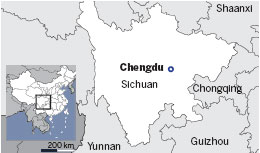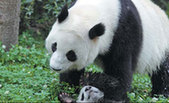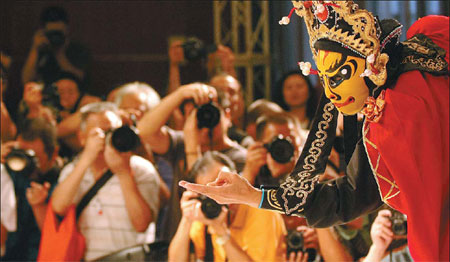At the heart of China
Updated: 2013-09-06 09:31
By Mei Jia (China Daily)
|
|||||||||||
With three days to spend in Chengdu, reserve one day for the pandas and two for local culture and food
Known as the hometown of the panda and hotpot, Chengdu, the capital of Sichuan province, enacted a 72-hour visa-free policy on Sept 1 for visitors from 45 countries.
Transit passengers holding valid visas and a flight ticket to a third country are now allowed to travel in the city and surrounding regions under the municipal government, making Chengdu the fourth city in China to allow visa-free stays.
With a history of 2,700 years, Chengdu is one of the few Chinese cities never to have changed its name. It's now the political, financial and cultural center of southwestern China.
The city strictly follows the square pattern of ancient royal cities in its primary layout.
Wars once decimated its population to nearly zero. To boost recovery, the emperor asked people from other southern provinces to move there. When different cultures, dialects and cooking methods were brought together, the resulting "Land of Abundance" spurred the birth of Sichuan cuisine, which has become the city's biggest attraction for many Chinese visitors.
|
A visit to Chengdu is not complete without getting up close and personal with the pandas. Zhu Xingxin / China Daily |
Now with the city government taking great pride in the fact that "half of the Fortune 500 companies are in Chengdu", it has resolved to lure more foreign visitors. Sichuan basin has a wide range of geographic resourses. Tourists are able to sample the wonders of grasslands, ice-capped mountains, hot springs and forests in one visit to the province.
Many streets in Chengdu have names with a story behind them, often connected to renowned poets and writers from the past, including literary luminaries Li Bai and Du Fu.
The city preserves a famous well from which poet Xue Tao of the Tang Dynasty (AD 618-907) drew water to make a handmade paper specially designed for poetry writing. Xue's residence is now a park in the city's southern part.
In recent years, many historical sites have been renovated. Here are some tips for anyone ready to rush to the city in a quest to discover local secrets and must-see places.
Day 1: Downtown pleasures
The moment you arrive in the city, you'll be surrounded by teahouses.
One of the best places to enjoy a cup is People's Park, where there is a traditional-style open-air teahouse. Take it easy and follow the locals. Get seated in the bamboo chairs and start with a jasmine tea.
In the meantime, enjoy the tea-pouring show, in which performers pour steaming water from a pot with a meter-long spout. Or treat yourself with an ear-cleaning service by the masters of this art found only in Sichuan's teahouses.
Then just relax and chat, play cards, or join in the mahjong games.

The restaurant Dumpling Zhong is next to the teahouse, offering genuine Chengdu snacks.
Order a set of special delicacies for around 30 yuan ($5), and you'll have more than 10 dishes including dumplings, wonton soup, cold dishes and desserts.
The park is also home to a monument commemorating the events that triggered the 1911 Revolution that changed the country dramatically.
The Shrine of the Marquis Wu, a must-see for history lovers, was built in AD 223 to celebrate the wisdom of Zhuge Liang (AD 181-234), prime minister of the Shu Kingdom.
Jinsha Museum, located in western Chengdu, preserves one of the 21st century's most significant archaeological discoveries on the original site. A gold mask and the Sun and Immortal Bird are among gold and jade articles, that date back about 3,000 years.
Restaurant Hong Xing, not too far from the museum, is a local favorite that offers renewed versions of classic Sichuan dishes.
Then, head to Broad and Narrow Alleys for a walk. The alleys are traces of old Chengdu that have survived the city's expansion and large-scale construction. Once home to Qing Dynasty (1644-1911) Emperor Kangxi's aristocratic soldiers from northern China, the alleys offer rare samples of northern courtyard houses found in southern areas. You'll also find stores, bars, restaurants, teahouses and hotels.
Immerse yourself in the hot and spicy world at Damiao Hotpot, or treat your eyes and stomach with Chengdu-style architecture and dishes at Chengdu Impression. Both host lively and humorous Sichuan Opera shows.
Watch closely: The actor's made-up red face can change to a white one in the millisecond he's talking to you.
Day 2: Panda, panda
As the habitat of the giant panda, Chengdu offers many chances to be up close and personal with these cute animals.
Chengdu Zoo is one option, but many visitors prefer going to the Chengdu Research Base of Giant Panda Breeding, about 10 km from the city.
There you can observe 121 pandas placed in different areas by age groups. Every panda has a name. They play with toys or with each other. If you're lucky to be there when there are newborn pandas, you can see the infants and how they are nursed.
Returning downtown after spending most of the day with pandas, you can jump into the city's night life. Two sub-branches of the Minjiang River merge in the city's southern part. Hejiang Pavilion overlooks the scene.
Near the pavilion and alongside the river, the Chengdu version of Hong Kong's Lan Kwai Fong is a new landmark for the city's young people and night owls.
Order anything and take in the beautiful views and interesting people around you.
Eastern Suburb Memory is a music-themed park. Like Beijing's 798 Art Zone, the park was formerly a factory that produced engines for aircraft and refrigerators. The industrial roar is long gone.
The night is now filled with the sounds of music from the bars and stages.
Day 3: Suburban delights
Many of the attractions of Chengdu are actually in the suburbs and surrounding countryside.
Mount Qingcheng, located about 70 km away from downtown, is one of the Taoist sacred mountains. Besides the cultural sites, the tall trees and clean brooks create a wonderful place for a hike in the fresh air.
The Dujiangyan Irrigation System was built around 2,200 years ago and still functions.
Popular haunts for the locals are the teahouses alongside the rivers. They serve tea, snacks and meals made with local vegetables and poultry. Mahjong lovers gather in them, too.
East of Chengdu's downtown, Luodai town is known for spicy snacks and cultural traces of former immigrants from other provinces. The most famous is a restaurant serving Tear-Drawing Bean/Rice Jelly. It's so hot and spicy that you can't hold back tears when eating it, but you can't quit because it's too delicious.
Huanglongxi ancient town is 40 km to the south of Chengdu. The old town preserves the former stone road, wooden houses and century-old trees, and has been the setting for a lot of Kungfu movies.
The Wenchuan earthquake in 2008 destroyed part of the town. After reconstruction, it reopened to tourists who can enjoy a boat cruise and meal along the river.
Or you can have a meal at a family inn in the countryside. Many families have turned their courtyard houses into inns. Every venue has its signature attractions, from specialty chicken dishes to picturesque fishing ponds, or simply beautiful natural scenes.
Shirley Zhang, Chen Xin and Pan Xiaowei contributed to the story.
meijia@chinadaily.com.cn
|
A face-changing Sichuan Opera performance is always a crowd-pleaser. Zhao Junchao / Asia News Photo |
(China Daily European Weekly 09/06/2013 page26)
Today's Top News
List of approved GM food clarified
ID checks for express deliveries in Guangdong
Govt to expand elderly care
University asks freshmen to sign suicide disclaimer
Tibet gears up for new climbing season
Media asked to promote Sino-Indian ties
Shots fired at Washington Navy Yard
Minimum growth rate set at 7%
Hot Topics
Lunar probe , China growth forecasts, Emission rules get tougher, China seen through 'colored lens', International board,
Editor's Picks

|

|

|

|

|

|







